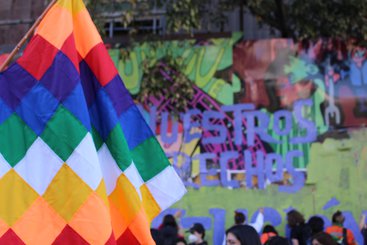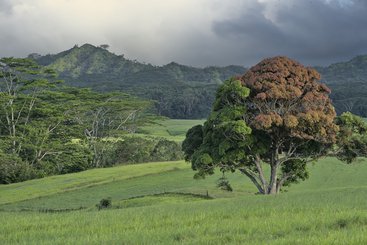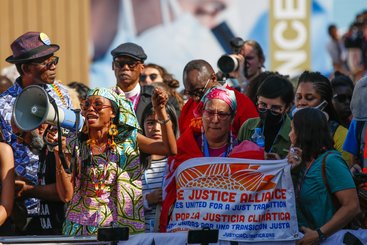The role of Indigenous Peoples' and Local Communities’ (IPLC) knowledge and approaches in safeguarding ecosystems and carbon sinks has been increasingly acknowledged over the past few years, and has been reflected at international conferences on climate and biodiversity, and in funding pledges. Following the UN climate change conference (COP27) and biodiversity conference (COP15) in 2022, ODI asked IPLC groups for their view of the progress on commitments made.
In 2021, the UN Framework Convention on Climate Change’s COP26 saw unprecedented focus on IPLC land rights, with IPLC representatives given a much higher profile in discussions. This year, its successor - COP27 - and the UN Convention on Biodiversity’s COP15 continued that work. IPLC rights were incorporated into many of the key targets agreed on at COP15, although there were concerns that IPLC groups were not sufficiently represented in negotiations.
In terms of biodiversity and nature conservation, the agreed recommendation framework published on December 19 highlighted 'the important roles and contributions of indigenous peoples and local communities as custodians of biodiversity and partners in [its] conservation, restoration and sustainable use.'
In the climate arena, in 2021 13 donors pledged $1.7 billion at COP26 to support IPLCs’ forest tenure. This year at COP27, a further 13 climate foundations pledged to mobilise an additional $2.1 billion.
But in the wake of these three major conferences, do IPLC groups think that efforts have moved far and fast enough to effectively protect their rights and stop the depletion of forests?
ODI - as co-host of the Prindex Land and Property Rights Initiative - spoke to two key IPLC representatives about their takeaways from COP27 and COP15. Gustavo Sánchez Valle is President of the Mexican Network of Forest Peasant Organizations and Executive Secretary of the Mesoamerican Alliance of Peoples and Forests; Cindy Kobei is an indigenous rights activist from the Ogiek community of the Mau Forest in Kenya, and Chair of the indigenous Ogiek youth council, Tirap Youth Trust. Both Gustavo and Cindy are involved in the UN climate and biodiversity processes.
Increased recognition: a step in the right direction
The increasing recognition in recent years of the importance of IPLC resource rights is partly a reflection of the growing body of research on the topic: securing and protecting land rights for indigenous groups can help safeguard the world’s tropical forests and protect biodiversity. It also springs from the increasing organisation and advocacy of IPLC groups, and an understanding of mistakes made in the past where a ‘fortress conservation’ approach saw IPLC groups forcibly removed from newly designated protected areas.
Both Gustavo and Cindy believe this recognition is a step in the right direction. 'Protecting indigenous peoples’ lands means protecting the world’s biodiversity…and climate solutions, because these are found in nature', Cindy told Prindex. 'The custodians of this knowledge and these climate solutions are indigenous people. Land justice is climate justice.' Likewise, Gustavo stressed that IPLCs’ community organisations 'are already investing in environmental issues', even before the recent funding pledges.
The next step: putting pledges into action
But putting these pledges into action will require work. Do the current pledges reflect what is needed to demarcate IPLC land, build IPLC and government capacity to protect those lands, and ensure IPLC groups will benefit from their stewardship?
According to Gustavo, while the funding pledged at COP26 is 'very important', people should be aware that this investment 'is still insufficient for everything that is required to stop climate change and have significant results.' To give one example: one of the targets set at COP15 was to progressively phase out by 2025 incentives or subsidies which are harmful for biodiversity, by at least $500 billion a year. By comparison, the $1.7 billion being directed to IPLC needs is a drop in the ocean.
However, Gustavo is hopeful that the investment can provide a starting point for the funding that is needed: the money pledged 'can inspire all governments to invest the necessary resources needed to adopt public policies to stop climate change.'
Enabling IPLC groups to drive the allocation of resources
In addition to insufficient funding, a lack of control over existing money is a critical missing step. Gustavo and Cindy both say that the funding committed to supporting IPLCs’ work protecting forests and biodiversity has not been distributed as fast as it needs to be nor to the people it should be targeting. Only 7% of funds disbursed by the IPLC Forest Tenure Pledge to date have gone directly to organisations led by IPLCs; around 50% was channelled via international non-governmental organisations. There is also a lack of transparency around where the funding is going: 'It's very difficult to know what is actually going on in regards to climate finance and funding distribution,' said Cindy.
Another big issue is representation. Cindy emphasised: 'There needs to be a mechanism to ensure that all the important groups [are represented:] our government representatives and indigenous persons representatives, a woman representative, a young person, and the private sector.' Together, these people would be better placed to 'make a strategy [for] how the money should be distributed to… priority communities.'
Gustavo also commented on the structural issues with the current system. 'The climate financing model is designed by governments, to serve other countries’ governments - or to serve very large actors or global NGOs. They have requirements that, in practice, are insurmountable for communities and their organisations.' There have been numerous calls to simplify the mechanisms for procurement and monitoring of project services, and strengthen IPLC monitoring mechanisms at global, regional, national and local levels.
Picking up the pace
Ultimately, Gustavo believes the key message for delegates at both climate and biodiversity COPs is simple: 'That we hurry. We have to do things right, but we need to speed up the pace.' Greater recognition of IPLC rights and increased funding are important steps, but work is not happening fast enough. As Cindy puts it: 'The question that we're always asking is ‘Where's the money?’. We went to COP27, and we're still asking, ‘Where's the money?’'
The pressure is on, post-COP27 and COP15, for progress on distribution of this spending commitment to the IPLC groups who need it.



